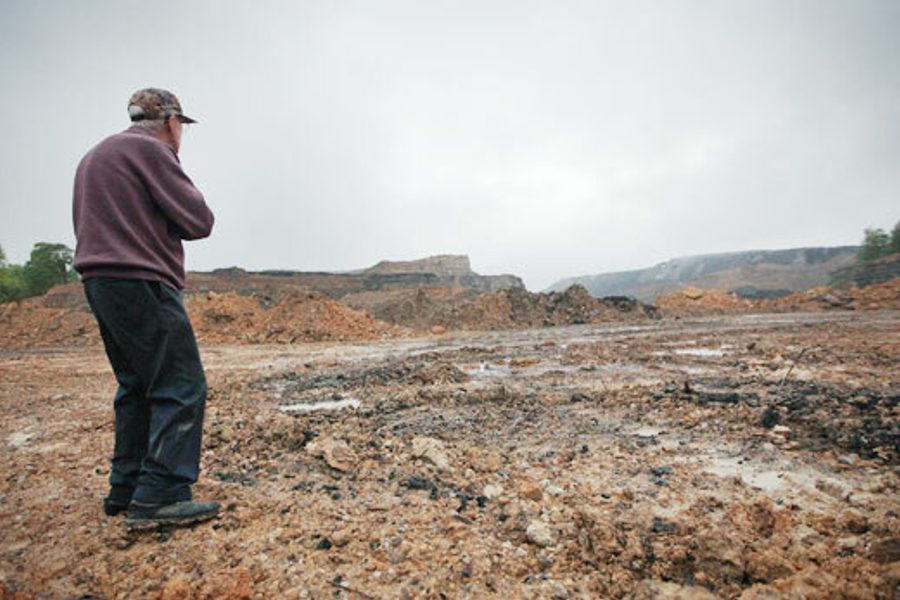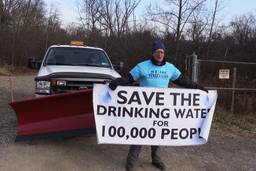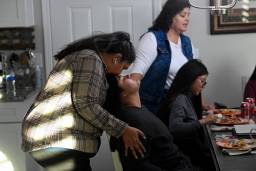Our Silent Spring
Fifty years after Rachel Carson’s warning call, have we learned anything?
Molly Bennet

Fifty years ago, America was on its way to being the kind of place few species would want to inhabit. Toxic waste flowed into rivers, soot floated out of smokestacks and pesticides were driving some species to the brink of extinction. Then, amid the turbulence of the 1960s and early 1970s, people began to realize that the earth might be something worth protecting. The result was our modern framework of environmental advocacy and regulation: Congress created the Environmental Protection Agency and passed landmark legislation like the Endangered Species Act, the Clean Air Act and the Clean Water Act; advocacy groups like Greenpeace, Environmental Defense Fund and the National Resources Defense Council were born; and older organizations like the Sierra Club were reinvigorated. On April 22, 1970, about 20 million people participated in the first Earth Day. The healing began.
It’s a familiar narrative – and would be a happy one if it ended there. Instead, today we face the gravest environmental threat that humanity has ever known – a threat that our system of environmental protection, so painstakingly constructed, is powerless to address. It’s been 24 years since NASA scientist James Hansen’s testimony before Congress brought global warming to the public’s attention. Yet despite the ceaseless work of activists and scientists, the carbon-fueled industrial economy that is wreaking havoc on the climate is still firmly in place. Neither the government nor the public evinces the will to confront it.
At such a critical moment, it is worth considering the book that first snapped the country out of its complacency and set the environmental movement in motion. In 1962, Rachel Carson’s Silent Spring asked us to reconsider the blind rush toward what the industrial world called progress. Carson warned us that by destroying the environment, humans would destroy themselves.
Somewhere along the way, her message has been lost.
The web of life
Silent Spring begins with an allegory about a pastoral town, alive with blooming flowers, flowing streams and singing birds. All is well in this village, until suddenly it isn’t. Bad things start to happen: The birds disappear, livestock starts dying, the countryside turns brown and dry, and children fall sick and die from a mysterious illness. Carson goes on to explain, in descriptions that are rigorously scientific and at times moving, how the effects of organochlorine pesticides, including DDT, reverberate far beyond their intended targets, disrupting the dynamic between species and their habitats and even making people sick. “No witchcraft, no enemy action had silenced the rebirth of life in this stricken world,” Carson wrote. “The people had done it themselves.”
First serialized in The New Yorker in June 1962, Silent Spring is credited with changing the way we understand the natural world and our place in it. The natural world is not, Carson explained, populated by independent organisms. Rather, each element – microbes, soil, insects, plants and animals – functions in a complex relationship with the others. The way the inhabitants of these systems play off one another is breathtaking, but caution is required; altering a single piece could trigger a chain of destruction.
Though common knowledge now, Carson’s ecological view of the world was a revelation to most readers. And she emphasized how we humans are part of this system. “Man is a part of nature,” Carson told an interviewer, “and his war against nature is inevitably a war against himself.”
“What Silent Spring did,” the environmental writer and activist Bill McKibben says, “was to cause people to start questioning, for the first time, and in a big way, whether modernity was quite as shiny as they’d assumed. Or whether there were deep hazards hidden right in the middle of the huge industrial enterprise.” McKibben, the founder of the environmental organization 350.org – 350 parts per million of carbon dioxide is the upper limit of what can safely exist in the atmosphere, according to many scientists; we’re currently at about 394 – has led the campaign against the Keystone XL pipeline. “It wasn’t just DDT that people were reacting to. It was the idea that things were not what they seemed, that they often came with a shadow attached. That’s a notion that’s grown, and it turns out that the biggest shadow of all is attached to the most ubiquitous chemical of all – CO2.”
“The modern world,” Carson wrote in 1963, “worships the gods of speed and quantity, and of the quick and easy profit, and out of this idolatry monstrous evils have arisen. … As for the general public, the vast majority rest secure in a childlike faith that ‘someone’ is looking after things – a faith unbroken until some public-spirited person, with patient scholarship and steadfast courage, presents facts that can no longer be ignored.”
Carson was referring to Ruth Harrison, a British animal-rights activist whose 1964 exposé of industrial livestock production, Animal Machines, Carson had agreed to preface. She was also, of course, referring to herself.
But Carson never got the chance to see Silent Spring’s impact reach as far as it did; she died of breast cancer in April 1964, at the age of 56. She may not have been altogether surprised, however – Carson carefully calibrated Silent Spring to achieve maximum effect, and in the two years following publication the book and its author were the subject of countless news stories, and even cartoons, as well as an episode of CBS Reports. Carson was invited to testify before a Senate subcommittee on the potential dangers of pesticides, and President John F. Kennedy asked his Scientific Advisory Committee to investigate the matter.
No one would have picked Carson out as the instigator of a wide-ranging social movement. Trained as a biologist, she was, according to her biographer Linda Lear, practical and reserved. She spent much of her career working for the U.S. Fish and Wildlife Service, where her aptitude for explaining complex scientific concepts in lucid prose led to her writing wildlife guides for the public. Meanwhile, she began selling stories to local newspapers about things like the oyster farms of the Chesapeake Bay.
In 1937, an article Carson published in The Atlantic Monthly titled “Undersea” caught the attention of an editor at Simon & Schuster, and in 1941 Carson published her first book, Under the Sea-Wind: A Naturalist’s Picture of Ocean Life. A second book, The Sea Around Us, followed 10 years later. Initially serialized in The New Yorker, the book made Carson famous and won her the National Book Award. It was also a bestseller, as was her third book, The Edge of the Sea.
But as advances in science and technology sped forward, something changed for Carson, and describing the wonders of the sea no longer sufficed. She became unsettled by the unknown costs of so much change. In a letter to a friend written in 1958, as she was preparing to begin work on Silent Spring, Carson explained what drove her to take on the project:
It was pleasant to believe, for example, that much of Nature was forever beyond the tampering reach of man … . These beliefs have almost been part of me for as long as I have thought about such things. To have them even vaguely threatened was so shocking that … I shut my mind – refused to acknowledge what I couldn’t help seeing. But that does no good, and I have now opened my eyes and my mind.
‘The public must decide’
Carson had long been wary of the new persistent pesticides like dieldrin and DDT, whose long-term effects she knew had not been sufficiently tested. She began work on the book after hearing from a friend in Massachusetts concerned by the number of dead birds on her land following a government spraying of DDT targeting mosquitoes. Carson’s research only deepened her conviction that the indiscriminate use of “biocides,” as she thought they should be called, could have disastrous ramifications for wildlife and human health.
Not surprisingly, the $300 million pesticide industry did not appreciate that Silent Spring had awoken the public to the dangers of its synthetic poisons. The campaign to intimidate and discredit Carson began even before Houghton Mifflin published the book. According to her detractors, Carson was emotional, reckless, an alarmist, a spinster and a Communist. As the president of the Montrose Chemical Corporation put it, she was “a fanatic defender of the cult of the balance of nature.” The pesticide manufacturer Monsanto published a parody of Silent Spring (one of several) that depicted a pesticide-free world overrun by vermin and stricken by disease and food shortages (even though Carson did not call for a total ban on pesticides). The ham-handed attacks not only drummed up excitement over the book, which immediately became a bestseller, they confirmed Carson’s warning that the public could not rely on the industry to provide honest information. Addressing the Garden Club of America in January 1963, she said, “We see scientific societies acknowledging as ‘sustaining associates’ a dozen or more giants of a related industry. When the scientific organization speaks, whose voice do we hear – that of science or of the sustaining industry?”
The chemical industry’s attack on Carson also underscored one of the clearest messages of Silent Spring (and of Carson’s other writings and speeches from the time): The public has a right to accurate, unbiased information about the potential impact of environmental decisions. Carson wrote Silent Spring out of a sense of obligation, based on both her fear of the consequences if pesticide use continued unchecked and her faith that an informed public will demand action. She wrote, “The public must decide whether it wishes to continue on the present road, and it can do so only when in full possession of the facts.”
Fifty years later, it seems Americans have failed to heed Carson’s lesson on the need to vigilantly seek out unbiased information and act on it. Of course, compared with today’s highly sophisticated and effective campaigns to undermine scientific conclusions about climate change, industry’s attacks on Carson seem quaint.
Science? What science?
In a confidential 2002 memo to party leaders on how to communicate with the public on global warming, Republican consultant Frank Luntz wrote, “The scientific debate is closing [against us] but not yet closed. There is still a window of opportunity to challenge the science.” That is exactly what proponents of the status quo have done. In The Hockey Stick and the Climate Wars: Dispatches From the Front Lines, published in March, climatologist Michael Mann details the industry-financed campaign to inject doubt into the public discussion of climate change. Mann was one of the authors of a paper in the late 1990s that presented the “hockey stick” – a graph that depicted the rise in global temperatures in the second half of the 20th century (picture a hockey stick laid on its side, blade pointed up). When the hockey stick became the most prominent visual illustration of global warming, Mann became the target of a campaign to discredit his work led by politicians like Rep. Joe Barton – the Texas Republican who over the years has received more than $1.5 million in campaign contributions from the oil and gas industry, and nearly that much from electric utilities, according to the Center for Responsive Politics.
The mainstream media, for its part, seems to have lost interest in the climate crisis. According to DailyClimate.org, global print and Web coverage of the issue fell 42 percent between 2009 and 2011. Media Matters found an even greater drop in the network television news coverage, which in 2011 devoted twice as much time to covering Donald Trump as it did to covering climate change. It’s little wonder that a March Gallup poll found that only 58 percent of Americans believe that most scientists think the planet is heating up. (Indeed, 97 percent of climate scientists think human-induced global warming is happening.)
Moving beyond a false choice
The last wave of heightened public interest in climate change occurred in 2006 and 2007, thanks in large part to Al Gore’s documentary An Inconvenient Truth, which brought in $24 million at the domestic box office. Then, of course, the economy collapsed, and people had more pressing concerns.
Silent Spring was published at a moment when the country was on the cusp of extraordinary social change. A robust economy gave Americans the opportunity to direct their energy outward, toward advancing social goals and building the Great Society.
We live in a very different time. It’s hard to think about the future when you’re struggling to hold on to your house and keep your family afloat. People like Van Jones, the “green jobs czar” who was pushed out of the Obama White House by a right-wing smear campaign, are trying to teach people that efforts to combat climate change can benefit the economy. Yet the same corporate interests that operate the denial machine have deployed the best flacks money can buy to sell the public on the false notion that addressing climate change will hit citizens in the pocketbook.
The Right has been using this strategy for years. Back in 2002, Luntz’s memo offered suggestions on “language that works” for talking to the public about global warming: “Unnecessary environmental regulations … mean less income for families struggling to survive and educate their children.” In a time of economic turmoil, this strategy is even more pernicious and successful.
Witness Oklahoma Republican Sen. James Inhofe’s revealing (in a number of ways) statement on The Rachel Maddow Show in March that he actually used to believe that global warming was happening – until he found out how much it would cost to address it. The ploy works. Promoting a false choice between environment and economy reinforces the disconnect many Americans feel between global warming and their own lives and communities.
But we can’t recreate the circumstances that strengthened Silent Spring’s impact, and we can’t wait for the economy to recover before we take action on climate change. Thankfully, grassroots campaigns around the world continue to take up Carson’s message that what destroys the natural world will destroy us.
The Sierra Club’s Beyond Coal campaign has had a hand in blocking the construction of more than 150 coal-fired power plants across the country. As Mark Hertsgaard recently explained in Mother Jones, Beyond Coal has succeeded as a grassroots effort in large part because it unites all different kinds of people – environmentalists, workers, public health advocates, concerned community members – to fight at the local level. Now Beyond Coal is working to close existing plants, incorporating the local economic impact of shutting down a plant into its strategy and plans, to ensure that lost jobs are replaced. So far, more than 100 plants have been closed.
There’s also some hope that as citizens begin to feel the effects of global warming in their own lives – from worsening allergies due to increased pollen to whole communities ravaged by natural disaster – they’ll look for an alternative future. This may already be starting to happen. A March poll conducted by Yale’s Project on Climate Change Communication and George Masons’ Center for Climate Change Communication showed that 69 percent of Americans are making the connection between global warming and the extreme weather events we’ve seen recently. And new polling suggests that public concern about global warming, which plummeted in the past few years, has risen slightly (though it’s still down from 2007 levels).
In the face of the corporate-backed PR campaign, the effort to build consensus to address climate change must again focus, as it did for Carson a half-century ago, on educating the public – about not just what’s causing climate change, but how it will change the way we live, and what we stand to lose if we remain passive. Whether it’s the Iowa corn farmer whose fields will be parched or the Alaskan fisherman whose village is sinking into thawing permafrost, every American has a stake in preserving the planet.
When it comes to motivating the public, McKibben says, “Global warming is the biggest problem humans have ever faced, so there are by definition a thousand ways in. You can come at it through jobs. You can come at it from psychology, economics of all kinds. It’ll take all these disciplines, and many more, to make an attack on the scale that we need.”
That challenge is greater than anything Carson could have imagined. But she would have risen to meet it, and so must we. If we don’t, future generations will look around the calamitous world and realize their ancestors failed the biggest test humanity has ever faced.

I hope you found this article important. Before you leave, I want to ask you to consider supporting our work with a donation. In These Times needs readers like you to help sustain our mission. We don’t depend on—or want—corporate advertising or deep-pocketed billionaires to fund our journalism. We’re supported by you, the reader, so we can focus on covering the issues that matter most to the progressive movement without fear or compromise.
Our work isn’t hidden behind a paywall because of people like you who support our journalism. We want to keep it that way. If you value the work we do and the movements we cover, please consider donating to In These Times.







